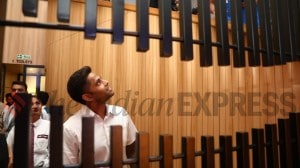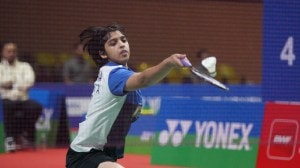Flip to a bold new beginning
Research in Motion aims to stay a step ahead of competition with three new BlackBerrys.

Research in Motion aims to stay a step ahead of competition with three new BlackBerrys.
WITH do-everything wonderphones like the iPhone and the G1 “Google phone” breathing down its neck, the BlackBerry’s status as the best-selling smartphone isn’t guaranteed forever. So this fall, Research in Motion is introducing three radically different BlackBerry models, running all of them up the flagpole at once to see who salutes.
First, there’s the $150 BlackBerry Pearl Flip 8220, the first folding clamshell BlackBerry. Second, there’s the $300 BlackBerry Bold 9000, a luxury-tinged design statement that screams, “Apple isn’t the only one who can do gorgeous!” Finally, there’s the BlackBerry Storm, the first BlackBerry with a touch screen. That last phone isn’t ready for review yet; evidently, that Storm is still brewing. But the Flip and the Bold are here—and they’re very, very nice indeed.
Both phones feature new software, loaded with useful programs and white line-drawing icons against a jet-black background. As on the BlackBerry Pearl and the Curve, you navigate by turning a tiny, clickable trackball.
As usual, the strength of these BlackBerrys is e-mail. The new software offers fully formatted e-mail—fonts, bold, italic and so on—and pictures embedded right in the message. Word, Excel and PowerPoint attachments open right up, ready for simple edits.
Since these are BlackBerrys, they have physical, illuminated thumb keyboards. A hundred ingenious shortcuts save you time. The much-improved web browser is still not as nice as the iPhone’s; you can’t rotate the screen for ease in reading wide columns, for example. And there’s no touch screen, so you can’t pinch or spread your fingertips to zoom in and out. Instead, web pages appear in miniature; you click the trackball to zoom in. It works well enough.
Both phones are sharp-looking, shiny and black, with bright, crisp screens. Removable battery, physical volume and camera keys and MicroSD memory-card slot are all standard. The Flip and the Bold can both hop onto wireless hot spots for speedy browsing and e-mail downloads. Each has a 2MP camera, with a tiny flash, that can also record video. Frankly, the photos and videos both look pretty lame—a rare exception to the “top-tier” mantra for these phones. In other words, a rock-solid, corporate-dependable, e-mail-centric heart still beats inside these flashier, catchier BlackBerry models. Yet the Flip and the Bold are actually aimed at opposite ends of the audience spectrum.
The Flip, intended for the consumer masses, works great as a clamshell; the outer screen identifies incoming calls, notifies you of new e-mail and even lets you see the first couple lines of your messages. And, of course, it is handy to be able to answer a call just by opening the hinge, and hang up by snapping it shut.
Still, the Flip costs half as much as the Bold, and that’s no accident. It is thickish, and it feels insubstantial. Worse, it is slow; you sometimes wait several seconds for the response to a button press. The software has a few bugs to be ironed out, too.
Like the BlackBerry Pearl, the Flip has only 14 keys to represent the whole alphabet. They’re huge, so they’re easy targets, but there are two letters painted on each key. The software generally figures out what word you’re typing, but fussy manual intervention is sometimes required.
On the flip side (ha!), the primary buttons below the screen are in two rows—Call and Hang Up above, Menu and Back below—which is easier to learn and feel than the Bold’s single row of four buttons.
The Bold, on the other hand, costs a jaw-dropping $300. It’s not svelte by any means—it’s much wider than an iPhone, for example, because of that broad thumb keyboard—but it looks like a million bucks. Like the iPhone, the front is black with a silver bezel, but the back panel is bold indeed: it’s pleather. Yes, that’s right: textured vinyl.
The Bold is a very fast little computer, responding instantly to every touch. A gigabyte of storage is built-in. The web and e-mail messages are speedy when you’re in a 3G network area. Phone calls on the Bold are unbelievably crisp and clear, and there’s enough power in the speaker to fill your office like a tabletop radio.
The Bold also has GPS with turn-by-turn directions. And like most BlackBerrys, you can charge it from any computer with any USB cable. (The Flip, alas, abandons this tradition and requires a special cable.)
You should note, however, that although the BlackBerry platform is now mature, it’s showing some cracks; with great features comes great complexity. Both phones make you look in three different places for a certain program: on the home screen, where you can park five favourite icons; in the “expanded home screen,” which lists a full panoply of icons; and in the Applications folder, which lists still more. This problem will only get worse when the online BlackBerry Applications Store—like the ones for the iPhone and Google phones—opens in March.
There are two different web browsers, two different e-mail programs, and, on the Flip, six different chat programs. Confusingly, there’s no unified design from one add-on program to the next. The Bold even comes with unsolicited trialware programs, just as on new Windows PCs. Is this what the cellphone is coming to?
Keep in mind, too, that a BlackBerry is not an iPod. There’s a music player, but it’s feels more like an afterthought. Music and video are nowhere close to being highlights of the machine, as on the iPhone.
Even so, RIM is firing on all cylinders these days. If e-mail figures into your mobile life more prominently than entertainment, then you’ll be very happy with either one of these phones.
DAVID POGUE, — NYT






- 01
- 02
- 03
- 04
- 05

























